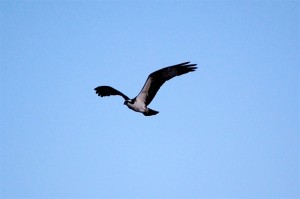Did you know Canada supports one third of the world’s osprey population?
The Osprey, Pandion Haliaetus, is a large fish eating bird of prey that is found worldwide and is often called “fish hawk”. Their diet consists almost entirely of fish. Although closely related to hawks and eagles, they are unique among raptors—possessing owl-like feet and wings that bend in flight like a gull—and the sole member of the genus Pandion and family Pandionidae. The osprey can be found on every continent except for Antarctica, and they look the same all over the world.
As Hunters: The osprey are expert hunters, well-adapted to catching live fish. Locating their prey from the air, ospreys will sometimes dive more than 100 feet, pulling up at the last moment before plunging feet-first into the water to capture a fish. Sometimes going completely underwater, the osprey has unique nostrils that close to keep out water. Their heavily muscled legs, powerful wings, and strong feet allow them to catch and fly off with fish up to three feet below the surface of the water! As the osprey rises in flight, it will grasp the fish firmly with two claws facing forward and two facing back. Adult ospreys are capable of carrying fish that equal their own size.
When the osprey emerges, it shakes the water from its feathers and then will arrange the fish in its talons to face forward to reduce drag during flight. Ospreys are very vocal, and utilize several calls including a begging call, and warning and alarm calls.
Click here to listen to an osprey. http://www.allaboutbirds.org/guide/osprey/id
Ospreys have several specialized and interesting anatomical features that distinguish them from other birds of prey. For instance they have a reversible fourth toe and very long strongly curved talons. They also have spines called “spicules” on their feet. All of these adaptations aid the osprey in holding on to its slippery prey.
The osprey is smaller than the bald eagles that typically share the same habitats, but its five to six foot wingspan is impressive nonetheless. Adults are dark brown above with a white underside and head. Look for the distinctive dark line that extends behind the eye and the gull-like way the narrow wings are angled downward when the birds are in flight. They grow to be about 2 feet long in adulthood. Adults generally weigh 2.5 to 4 pounds, with females tending to be slightly larger than males. While they normally top out at around 30 – 40 miles per hour in flight, ospreys are capable of reaching 80 mph in steep dives while hunting fish.
Nests & Breeding: Osprey nests are among the largest built by any bird. Measuring at least 3 feet deep and 5 feet across, their nests consisting of a mass of sticks in the tops of dead trees, navigational buoys and man-made platforms. The nests may be reused over many years. Ospreys have adapted so well to artificial nest sites that the species now nests in areas (e.g. inner cities) once considered unsuitable. Osprey in the area generally lay their eggs from April to June. Osprey eggs are about the size of chicken eggs, and they range in color from off-white to pinkish with cinnamon-colored splotches. For 32 to 35 days or longer, the pair incubates two to four. Covered in down and weighing only two ounces when they hatch, osprey chicks will begin to grow feathers almost immediately, and will be ready to test their wings within 5 to 7 weeks. Chicks are hatched with brownish, reddish, or orange-tinted eyes, which change as they mature to a bright yellow color.
Their eggs are incubated for about 40 days. Chicks fledge in Mid-July when they are about 2 months old, however they remain close to the nesting site for another three weeks or so dependent on the parents for food.
Ospreys mate for life. The female is larger than the male and has more dark feathers around the neck. If a mate dies then the osprey will find a new mate. Ospreys usually have 2 young but sometimes it is only 1 and sometimes there are 3! Young ospreys have white tips on the end of their dark feathers giving them a ‘mottled’ look. The young Osprey continue to use their nest as a feeding platform after they fledge for another three weeks. Fledging is flying away from the nest for the first time. Some young ospreys seem to need more help from their parents then others however, ospreys fishing talent is thought to be innate which means that skill exists from birth or is a natural instinct.
Osprey breed in Ontario between April and September. In September, they head south to spend the winter months in Central and South America. While migrating, ospreys will usually travel during the daytime, only occasionally traveling by night.
Threats to Ospreys: Loss of habitat, emaciation, trauma, poisoning, and shootings are all among the threats to ospreys. Many ospreys perish due to starvation and many are killed by being hit by cars. In highly urbanized environments ospreys can nest on many man-made structures but long term they will always need branches to build their nests no matter where they are.
The osprey suffered considerably during the mid 20th century. The effects of DDT contamination caused the eggs to have very thin shells that were easily broken under the weight of the incubating adults. As a result, osprey numbers dropped drastically in much of North America. Since the banning of DDT in the mid 1970s, populations of this magnificent bird have recovered considerably.

